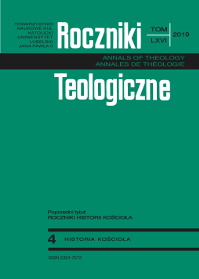Christian Protology and Eschatology Formed by Pagan Letters. Base on Cento De Verbi Incarnatione
Abstract
The article shows Christian protology and eschatology issues in the Cento De Verbi Incarnatione. The main goal is to show how the centoner used Virgil’s words to create Christian theology in his poem. Did he only use letters or maybe also the context from the Aeneid, Bucolics and Georgics? In searching for similarities and differences between De Verbi Incarnatione and Virgil’s poems, we analyzed a few parts on teachings about the creation and the end of the world, the existence of Satan, sin entering the world, the results of sin and eschatology in general.
The centoner in his work mainly uses the lexical level of Virgil’s works, though in most cases, he does not include their context. In the Cento, we can find many similarities between Christian figures in various works and the characters that appear in the works of greatest poet of the Augustian age.
References
Augustini S., Epistulae, pars III, ep. 137, Al. Goldbacher, Vindobonae–Lipsiae 1904.
Cullhed S.S., Proba the Prophet. The Christian Virgilian Cento of Faltonia Betitia Proba, Leiden 2015.
Drzyżdżyk Sz., Chrystologia w perspektywie Mitu Trojańskiego, Scriptum, Kraków 2017.
Drzyżdżyk Sz., Demonologia Homerocentonów, „Bielsko-Żywieckie Studia Teologiczne” 2016, nr 17, s. 89-98.
Gilski M., Mariologia centonów, Scriptum, Kraków 2015, s. 195-208.
McGill S., Virgil Recomposed. The Mythological and Secular Centos in Antiquity, Oxford 2005, s. XV.
Migdał M., Piątek M., Chrystologia „Christus patiens”, Scriptum, Kraków 2017.
Piasecki D., Centony Homeryckie, Scriptum, Kraków 2017.
Piasecki D., Centony Homeryckie – spotkanie tradycji pogańskiej z chrześcijańską, Scriptum, Kraków 2014.
Piasecki D., Hermeneutyka Centonu Homeryckiego – studium przypadku, „Littera Antiqua” 2011, nr 2, s. 117-132.
Piasecki D., Pochodzenie nazw własnych w Centonach Homeryckich, „Littera Antiqua” 2012, nr 5, s. 101-114.
Piątek M., Miejsce, rola i wykorzystanie tragedii „Prometeusz w okowach” w chrześcijańskim centonie „Christus Patiens”, „Bielsko-Żywieckie Studia Teologiczne” 2017, nr 18, s. 195-205.
Poetae Christiani Minores, CSEL, vol. 16, pars 1, Vindobonae MDCCCLXXXVIII, s. 615-620.
Stabryła S., Wergiliusz – świat poetycki, PAN, Wrocław 1983.
Stehlikova E., Centones Christiani as a Means of Reception, „Listy filologické” 1987, nr 1, s. 13.
Trisoglio F., La struttura del „Christus patiens”, „Orpheus. Rivista di umanita classica e cristiana” 1995, nr 16, s. 330-365.
Trisoglio F., La Vergine Maria come protagonista del Christus patiens, „Marianum” 1979, nr 41, s. 199-266.
Virgile, Bucoliques, Les Belles Lettres, Paris 1992.
Virgile, Géorgiques, Les Belles Lettres, Paris 1995.
Virgile, Énéide, Les Belles Lettres, t. 1, Paris 1977.
Virgile, Énéide, Les Belles Lettres, t. 2, Paris 1993.
Virgile, Énéide, Les Belles Lettres, t. 3, Paris 1987.
Wergiliusz, Eneida, Zakład Narodowy im. Ossolińskich, Wrocław 1980.
Wojtylak-Heszen A., Tragedia późnoantyczna ΧΡΙΣΤΟΣ ΠΑΣΧΩΝ a jej klasyczne źródła, Collegium Columbinum, Kraków 2004.
Ziółkowski J.M., Putnam M.C.J., The Viriglian Tradition. The First Fifteen Hundred Years, New Haven–London 2008.
Copyright (c) 2019 Roczniki Teologiczne

This work is licensed under a Creative Commons Attribution-NonCommercial-NoDerivatives 4.0 International License.





